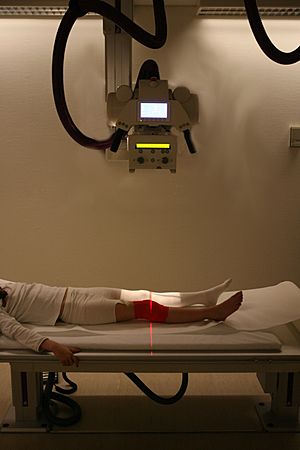Radiology facts for kids

Radiology is a special part of medicine. It uses amazing pictures from inside your body to find out what might be making you sick. Doctors also use these pictures to help treat illnesses. It's like having a superpower to see inside without needing to open you up!
Doctors use different ways to take these pictures. Some common ones are X-rays, ultrasound, CT scans, and MRI scans. There's also something called nuclear medicine, which includes PET scans. Sometimes, doctors even use these imaging tools to guide small medical procedures. These procedures are often "minimally invasive," meaning they don't need big cuts.
Contents
What is Radiology?
Radiology is a medical field that focuses on using different types of energy to create images of the inside of your body. These images help doctors see bones, organs, and other body parts. By looking at these pictures, doctors can find problems like broken bones, infections, or other diseases.
It's not just about finding problems. Radiology also helps doctors plan treatments. Sometimes, they even use imaging to guide tools during a procedure. This makes sure the tools go to exactly the right spot.
How Doctors See Inside Your Body
There are many cool ways doctors get pictures from inside you. Each method uses a different type of technology.
X-rays: Seeing Your Bones
X-rays are one of the oldest and most common imaging methods. They use a small amount of radiation to create pictures of your bones. X-rays are great for finding broken bones or checking for problems in your lungs. When you get an X-ray, you stand or lie still while a machine takes a quick picture.
Ultrasound: Using Sound Waves
Ultrasound uses high-frequency sound waves to create images. These sound waves bounce off your organs and tissues. A computer then turns these echoes into a live picture on a screen. Ultrasound is often used to look at babies before they are born. It's also used to check organs like the heart, liver, or kidneys. It's completely safe and doesn't use radiation.
CT Scans: Detailed 3D Views
A CT scan, short for Computed Tomography, uses many X-ray images taken from different angles. A computer then puts these images together to create detailed cross-sectional pictures. Think of it like slicing a loaf of bread and looking at each slice. CT scans can show bones, soft tissues, and blood vessels very clearly. They are useful for seeing injuries, tumors, or internal bleeding.
MRI Scans: Using Magnets and Radio Waves
MRI stands for Magnetic Resonance Imaging. This method uses strong magnets and radio waves to create detailed images of organs and soft tissues. Unlike X-rays or CT scans, MRI does not use radiation. It's especially good for looking at the brain, spine, joints, and muscles. During an MRI, you lie inside a large tube, and the machine makes some loud knocking noises.
Nuclear Medicine and PET Scans
Nuclear medicine uses tiny amounts of radioactive materials. These materials are given to you, usually through an injection. They travel to specific parts of your body. Special cameras then detect the energy from these materials. This helps doctors see how organs are working, not just what they look like.
A PET scan (Positron Emission Tomography) is a type of nuclear medicine scan. It can show how well your organs and tissues are working at a cellular level. This helps doctors find diseases very early.
The Radiology Team
Many skilled people work together in radiology to help patients. It's a real team effort!
The Radiologist: The Picture Reader
A radiologist is a medical doctor. They have special training to understand and interpret medical images. They look at your X-rays, CT scans, and MRIs. Then, they write a report explaining what they found. They also talk to your other doctors about the results. Sometimes, radiologists also perform small procedures using imaging guidance.
The Nurse: Patient Care Expert
Nurses in radiology help patients before, during, and after their imaging tests. They might give you medicines or check your vital signs. They also make sure you are comfortable and safe, especially if you need to be sedated for a procedure.
The Radiographer: The Image Maker
A radiographer is a specially trained healthcare professional. They are the ones who actually take the pictures! They know how to use the complex imaging machines. They also know how to position you correctly to get the best images. Radiographers are sometimes called "radiologic technologists" in some countries. They play a very important role in getting clear pictures for the radiologist to read.
Images for kids
-
Image from a CT scan of the brain
See also
 In Spanish: Radiología para niños
In Spanish: Radiología para niños



